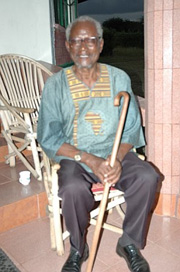 So I hope you all find this as amazing as I did……
So I hope you all find this as amazing as I did……
As some of you know, I came to Kunya by pure fate. I had been randomly researching volunteer opportunities on the web when I found a program called Village Volunteers. The program and the founder/director seemed a perfect fit for me right away and so, without knowing a whole lot, I decided that it was the program for me. I couldn’t have been more right. I love when a gut feeling is right. Not only has my experience been amazing (tough but amazing), I have had the opportunity to get to know a man and a family who have played an absolute amazing role in Kenya’s history. I may have mixed up a couple of facts here and there as I was scribbling like mad to get them all down, but essentially I got them all down correctly. Here is the story:
Living next to us on a compound in Kunya Village is an 85 year-old man named Mzee Oneko and his wife. Mzee is the polite/respectable word here for “old man”. It’s commonly used. Mzee is the father-in-law of Joyce, the amazing woman who founded/runs Mama na Dada. She is married to one of Mzee’s 12 kids.
Mzee was a Freedom Fighter in Kenya – one of a handful of men who led the successful fight for Kenya’s independence from Britain. He was colleagues/friends with the first President of Kenya, Jomo Kenyatta and served as the Minister of Information when they successfully won independence. But that is only a part of the story. The following info is where this story and man become amazing!!
Mzee was born in the 1920’s after his grandfather had returned from WW 1. His grandfather had been forced to fight on the British side in the war since Kenya was still governed by Kenya. While serving, he learned that it was essential to know how to read/write. So many Kenyans did not and he saw how that directly affected the jobs the Kenyans were given in the military. He returned home and made sure all of his children went to school. Mzee went to primary school in nearby Bondo, walking from Kunya which is a 30-45 minute drive by car!!!!!!!!!!! Mzee also went to secondary school, which very few people were doing at that time.
Once he completed school, he was working in a meteorology department in Kisumu, talking a lot among his intellectual colleagues about the possibility of Kenya’s independence. He began to put his ideas into writing by a paper called Ramogi (which is the name of the great founding grandfather of the Luo tribe of which he belonged). The paper put forth ideas all about freedom and independence. From Kisumu, he went to Nairobi and started a similar paper with his colleagues and also began forming political groups who were advocating independence for Kenya. He was instrumental in forming the first well-known African political party – Kenyan African Union (KAU).
Things started really heating up as the KAU took root and Kenyans began actually believing that they could rule themselves. So much power was the KAU starting to have that the British government had no choice but to recognize them and begin talks. They, of course, hoped to talk and push them aside. The KAU had other plans.
Around 1951, the British called members of the KAU to London to explain what the KAU was all about. Mzee led the delegation. At the end of the meeting, the British were not happy and made it clear they would not allow the Kenyans to rule themselves. Mzee returned to Kenya declaring “The tree of freedom is watered by blood.” This statement has followed Mzee for years and essentially fueled the fight between the Kenyans and the British! The momentum had been found – riots broke out in the cities, strikes were going on across the country and in the rural parts, tribesmen were running to the forests in order to orchestrate their attacks on the British. This fight was having success because it was NATIONAL and not tribal. Finally, most Kenyans were fighting on the same side. Things were very bloody in Nairobi.
By 1952, the main political leaders including the Mzee, Jomo Kenyatta and 4 others were rounded up and imprisoned. Joyce’s husband Mike (son of Mzee) was born in October of this year. Mike and his family had to go into hiding for fear that the government would round them up to threaten, kill or imprison them as well. Mike had three brothers at the time and all went into hiding with their mother. The Mzee was detained for 7 years!!! During this time, many people were also being imprisoned where they were tortured and even killed.
In 1959, Mzee was released from prison but was “detained”. The detainees were allowed to have 1 wife and 2 children live with them in the detainment camp. Mike met his father for the first time when he was 8 years old. Upon meeting him, he said, “Hello. You look a lot like my uncle.” They lived in the detainment camp for 3 years together. Mzee and is fellow detainees served as teachers, teaching the children subjects including math, English, Swahilli, etc. So Mike was educated by his own father for 3 years.
After the 3 years, they were eventually released and allowed restricted movement in the area of Kunya. In time, the restrictions were eased and they were finally allowed to travel freely. Eventually, Mzee headed back to Nairobi to continue the fight for freedom. And in 1963, the first elections were held and Jomo Kenyatta was elected President. Mzee went to Nakuru, a predominantly white farming area where he was elected as the first Member of Parliament (MP) under the new government and served as the Minister of Information. The KAU was now called the Kenyan African National Union (KANU).
After 4 years, Mzee and some other political colleagues were growing disenchanted with the government they had been a part of. Kenyatta was dismissing important land issues. Before coming into leadership, Kenyatta, Mzee and the others had agreed that any Kenyan who had lost land or loved ones during the fight for independence should be compensated. Kenyatta was now dismissing this idea and not keeping his promise to the people. Mzee was furious. So Mzee and some colleagues formed an opposition party.
And that promptly landed him back in prison for 6 more years – this time imprisoned by his former colleage and Freedom Fighter, President Jomo Kenyatta!!!!!!!!!!!!!!
He was released again in 1975 and went on to become an MP again representing his own area of Nyoma, where he now currently resides. Kenyatta went on to become a dictator and KANU enjoyed long success in running Kenya. Others like Mzee kept fighting to establish other political parties who could oust KANU.
In 1990, Kenya had its first multi-party election!! KANU won after having been the only party ruling Kenya for 30 years. Rumors of election rigging (including what was written in my Kenyan travel book) plagued the country and were considered by outside countries lending financial support to Kenya. But soon, the country and those outside accepted the elections results. I asked Mike whether he thought the election was rigged and he said NO. The reason KANU won, despite the fact that the party had become synonymous with dictatorship was because it had been all the people knew. Change was scary. And the opposition parties were still small and unorganized.
And so Mzee is now retired. He is the longest detained political prisoner in Kenyan history. And he is the oldest living original MP.
While most other MPs chose and still choose to make money, he owns only the home he lives in in the village of Kunya. His house is simple and has no electricity. He spends his days sitting in a chair underneath a beautiful Indian tree in his yard gazing at the beauty of Lake Victoria. His wife spends her time minding the many chickens they have.
They enjoy visitors almost daily. Just last year, the road through Kunya (there is only one 4 km road) was mended (by crushed gravel) in honor of Mzee. Politicians from all over come to meet with him, hear his stories and seek his advice. He has managed to say amazingly humble and welcoming. His children are all educated professionals (one leading the Department of Tourism, one a doctor, Mike is consultant, one a fisherman, etc.)
I have met Mzee several times – the first when I asked for his help in finding me a carpenter to build me a boat. I have visited him numerous times since just to chat and say hello.
While I gathered he was important figure of some sort, I had no idea that he was a Founding Father of Kenya, a Freedom Fighter and the longest detained political prisoner in Kenyan history. Word on the street that he is as clean as they come – always fighting for the people of Kenya and never using his positions of power to get rich – which is THE thing to do in Kenyan politics.
And so that is my brush with an amazing man who made such a difference in Kenya. And he lives right next door!
Hope you all enjoy this little slice of Kenyan history. I found it fascinating!!
Sue Bell
May 2005
